-
Nader T. Homayoun: Tehroun (2009)--ND/NF

SHAHRZAD KAMAL ZADEH AND THE RENTAL CHILD IN TEHROUN
Nader T. Homayoun: Tehroun (2009)
The seamy side of the Iranian capitol
In Tehroun (the name is just a local vernacular way of saying "Tehran") a woman who poses as a student for purposes of daytime prostitution tries to sell a small child that has been rented out for begging. Nearly everyone in this movie is desperate and using some scam to get by. A small gang of outlaws a man joins to pay an extortionist when the child is stolen poses as religious police to rob rich party people; and, uniformed as cops, stops cars on the highway uniformed as cops to take the occupants' jewelry. But for revenge, the rich victims run over and kill one of the bandits. An innocent wife, pregnant, takes to drug smuggling on her own to help out when she learns her husband is in a financial fix with a gangster. In the end, it's hard to tell if this is a movie about the moral depravity of contemporary Iran -- or the degenerative effect of the country's huge capital city -- or an indictment of the regime, for driving citizens to extreme survival strategies. Whether there are any heroes here or only villains is uncertain. One thing is clear: that Tehroun, which was made on the sly, would not appeal to the mullahs. A French poster calls this "A film noir, Iranian style: a little revolution," and in the course of developing its "polar" (crime story) plot, if that's what it is, Homayroun certainly gets away from the continually weepy and tendentious manner of Iranian cinema (as has Jafar Panahi) and takes risks, but he has woven a tangled web whose ultimate point is moot.
As the film begins, Ibrahim (Ali Ebdali) has for some time been away from his provincial home and wife trying his luck in the capital. Having run low on money, he has rented a baby boy from a gangster to beg in the streets, wandering from car to car and later walking the sidewalk. He doesn't do badly. In the evening we see him sharing a room with a bunch of men, including a pal who drives a taxi. He has full-time custody of the kid and must feed him and buy salve for his gums because he's teething, and periodically has to go back and pay rental fees to the gangster. Trouble comes when one day the cab driver, who normally takes Ibrahim to his daily begging rounds, finds him a temp job gardening for a rich lady. Ibrahim must leave the kid with young roommate Madjid (Missagh Zareh), who takes the boy to a park where he's accosted by the fake student prostitute, Shirine (Shahrzad Kamal Zadeh) and can't resist her; apparently he's a virgin. When Madjid leaves the baby with Shirine to rent a hotel room she runs off with him. Meanwhile Ibrahim's wife, now pregnant, is coming to town. He has to stay with her in a cheap hotel to hide his actual circumstances.
Things get more and more complicated, and there are various stray plot developments. Ibrahim is assisting at the cabbie's Muslim wedding ceremony when the latter, comically, gets a phone call telling him the lost rental child has been found.
Hamayroun, whose first feature this is, keeps the action flowing, but doesn't develop character or suspense. One watches with curiosity more than emotional involvement. The theme of the gangster has much potential that is wasted. He appears kindly at one point, cruel at another. In a cruel phase he tortures Ibrahim by using a small crane to lower him head first into a pool. Later he is caught off-screen and exposed as a child trafficker, but by then has apparently been rubbed out -- by Ibrahim and friends, perhaps, we don't know.
The images are of poor quality, as murky as the characters' morals. Sometimes important plot twists are likewise unclear. While the early sequences of the lost child may bring to mind De Sica's Bicycle Thief, the ending in a huge bus station might evoke Clément's Forbidden Games -- except that it's used as the setting for final gratuitous plot twist. This is rich material -- perhaps too rich -- clumsily utilized, though the film has already won an audience award at Venice and may be welcomed by more admiring than critical fans of Iranian cinema. The screenplay was co-written with Mehdi Boustani and Jean-Philippe Gaud, who collaborated with Homayoun previously on a short.
An Iranian/French co-production scheduled for an April 14, 2010 release in France, Tehroun was included in the New Directors/New Films series in late March 2010 in New York with showings at the Walter Reade Theater of Lincoln Center and MoMA.
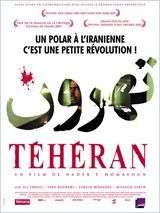
FRENCH POSTER FOR TEHROUN
Last edited by Chris Knipp; 03-25-2010 at 06:51 PM.
-
Laura Poitras: The Oath (2010)--ND/NF
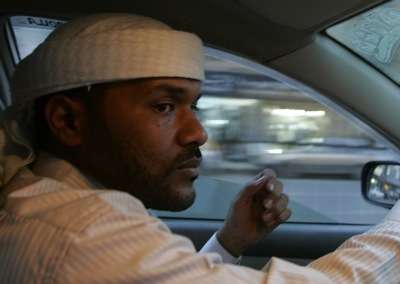
"ABU JANDAL" IN THE OATH
Laura Poitras: The Oath (2010)
Salim Hamdan of the Supreme Court case Hamdan vs. Rumsfeld is in a sense the silent protagonist of Laura Poitras' The Oath. He is a notable figure, arguably an embarrassment, of the US "War on Terror" rarely seen or heard from in this documentary about jihadism, 9/11, and the Guantánamo Bay prison, but nonetheless important. Hamdan vs. Rumsfeld was the habeas corpus case. The decision against the government and for Hamdan gave Guantánamo defense lawyers, and citizens disturbed by post-90/11 rights violations, tremendous hope. It found that military tribunals of detainees violated both the Uniform Code of Military Justice and the Geneva Convention. But three months later Congress under Bush administration pressure passed the Military Commissions Act, allowing the prisoners to be tried by that format. Hamdan was tried again. He was not found guilty of terrorism, only of material support, and was released back to his home country, Yemen, in five months (having already been held five years). Since then, he has refused to make any appearances or give any interviews. In Poitras' documentary there are readings from Hamdan's letters, a tape recording, and a grainy short film of his original arrest, no direct appearance or interview. Poitras does cover the story of Hamdan vs. Rumsfeld and the military commission, in particular showing press statements by Lieutenant Commander Charles Swift, Hamdan's remarkable young defense lawyer.
Hamdan was Osama bin Laden's driver in Afghanistan. He went there with fellow jihadi Nasser al-Bahri. Al-Bahri, who chose the nom de guerre of "Abu Jandal," became the al-Qaida leader's bodyguard and self-declared "hospitality emir," running his guest house where new arrivals were processed. Since Hamdan and Abu Jandal married two sisters at the instigation of al-Qaida, they are brothers-in-law (Abu Jandal's children call Hamdan "uncle").
The living voice of The Oath is Abu Jandal. When the 9/11 attacks occurred, Abu Jandal had been in prison in Yemen successfully undergoing a kind of re-education, and Ali Soufan of the FBI and Robert McFadden interrogated him, using peaceable methods and gaining his confidence. Abu Jandal was shocked to learn that the attacks were carried out by many of the men he had met at Bin Laden's hospitality house, and was prompted to give many details about al-Qaida as he knew it to the FBI. He was subsequently released and set up as a taxi driver in San'a, Yemen's capitol.
Poitras shows Abu Jandal at home with his young son, Habib; talking to young acolytes, whom he indoctrinates in a kind of peaceful jihadism; and driving his taxi, where a camera was mounted. He shows himself to be a kindly, intelligent man -- as apparently, so is Hamdan. The filming was done over a two-year period, and toward the end of it Abu Jandal reports Hamdan is (like other Guantánamo ex-prisoners as we know them) now a changed man, very inward and anti-social, trusting only men he was detained with. Abu Jandal himself has become buried in debt, has had to sell his taxi to raise money, and may lose his house. There's a moving scene in which he teaches Habib a passage from the Qur'an about keeping to the straight path no matter what, when there is a slight desperation in his voice. Before this he has occasionally described himself as sleepless, fearful for his family and himself because he is resented for what he did, and guilty about his friend Salim Hamdan's sufferings due to his Guantánamo incarceration, because he inspired both of them to go to Afghanistan and offer their services to al-Qaida and Bin Laden.
So this well-shot and well-edited documentary is primarily a portrait of Abu Jandal, a former jihadi who has turned away from advocating violence, a man who recognizes the value of striking at the heart of America's symbols of power as the 9/11 attacks did, but would not advocate or participate in any such actions.
This is the second of a planned trilogy by Laura Poitras. The "oath" of the title is the al-Qaida loyalty oath both men took. The film makes use of its own material, and also files such as the Guantánamo-related press appearances, an ABC interview with Abu Jandal, a "60 Minutes" piece based on lengthy interviews with him, and a searching Yemeni TV interview. Most of the film is in Arabic. Poitras refrains from taking a stand, but has said elsewhere that America needs to see "Islamic radicals as real people," and has pointedly called 9/11 and the US reaction "twin tragedies." This is conceived as the second part of a trilogy. The first was My Country, My Country, a look at the US occupation of Iraq from the perspective of an Iraqi doctor. The third is to focus on the 9/11 trials.
Poitras' aim with The Oath was to make a film about a released Guantánamo prisoner, but she shifted to Abu Jandal (adding in the parallel story of his famous brother-in-law) when she got to Yemen and met him. He is an interesting subject, but the inclusion of so much other material somewhat detracts from his portrait. This subject of a jihadi in limbo and in economic straits is also treated in Mahmoud al-Massad's 2007 Recycle (shown at the San Francisco film festival of 2008). Both Salim Hamdan and Abu Jandal remain puzzling figures, committed to jihadism and al-Qaida, at one time anyway, yet curiously gentle, sweet men; so close to Bin Laden, yet so uninvolved in planning or execution of any terrorist acts.
Included in New Directors/New Films and shown at Lincoln center and MoMA in March 2010, The Oath, like Lixin Fan's Last Train Home, was recently bought for US distribution by Zeitgeist Films. Both were successes at Sundance. The Oath won the Best Documentary Cinematography award there.
P.s.: Opened in NYC at IFC Center May 7, 2010. NY Times review (Mike Hale).
Last edited by Chris Knipp; 05-14-2010 at 06:37 PM.
-
Warwick Thornton: Samson and Delilah (2009)--ND/NF

MARISA GIBSON AND ROWAN MCNAMARRA IN SAMSON AND DELILAH
Warwick Thornton: Samson and Delilah (2009)
Star-crossed lovers in the Outback
Samson and Delilah is a terribly sad and touching tale of an Australian aboriginal boy and girl. The film, which won the Caméra d'Or award at Cannes for the best first feature, and "golden camera" suits its warm, luminous images, has a long downward trajectory that rights itself just in time toward the end. There is the comfort of a moment of mild hope when the teenage couple settles, after desperate times, in a remote Outback location. We leave them at peace, the girl returning to her craft of making paintings for sale to Alice Springs galleries, the boy attempting to end his substance abuse. A romantic song declares that they will always have each other, thus underlining that this is not a tract or horror film but a love story, and that a cinema of identity is also a cinema of hope. Songs are well used, and so is light. Thornton shows a sure touch and knows how to tell a story, conveying clear messages in long wordless takes that draw you in and grab your heart.
This is a first feature by a young aboriginal director, who wrote, shot, and directed (editing is bey Roland Gallois). Thornton takes us into the lives of his characters with sensitivity and delicacy, and all the vividness of an Italian neorealist film. Samson (Rowan McNamarra) lives in a nearly empty house with his brother, who spends the day out front with a little band playing the same reggae song over and over. Samson grabs a guitar and tries some riffs every day, and is chased away. He consoles himself morning and night by sniffing gasoline. He becomes attracted to Delilah (Marissa Gibson), who sleeps nearby and cares for her aging, ailing Nana (Mitjili Gibson), and spends part of each day making paintings with her. These are bought by a gallery owner for a small fee and sold in Alice Springs for tens of thousands of dollars. Deilialh also pushes her grandma in a rickety wheelchair to a ragged health center and to a chapel where she sits a while and prays.
Samsom's overtures to Delilah are crude. He scribbles a message on the wall, throws stones at her, and throws his mattress over the fence into her property. Their relationship is largely wordless. When anyone around does speak, it's in aboriginal language, except to exchange a few words with The Man, in this case the gallery owner. The early encounters between the pair are rough but also playful and funny.
One day follows another, though the two kids seem to be waking up closer together. Delilah amuses herself sitting in a car listening to a cassette tape of Latin music. One evening Samson does a wild, sexy dance where she can see. Eventually the morning comes when Delilah wakes up to find her grandma dead. In mourning the girl cuts off her hair with a bread knife. Higher than usual, Samson attacks one of the musicians, and is beaten. The girl is beaten with sticks too, by family members who accuse her of causing her grandma's death by misusing her or not giving her her medications.
Impulsively Samson and Delilah run away to Alice Springs in a stolen truck. He siphons off a bottle of gas from a car to keep going, and begins sniffing gasoline almost continually. From then on things get worse and worse. They wind up sleeping under a bridge near a once reasonably well off aboriginal man called Gonzo (Scott Thornton) who has declined through drink. Gonzo, who has a gaiety about him, and speaks only English, provides the kids with food, mostly noodles. They shop at a grocery store and Samson steals some extras. They're close now, a couple too miserable to make love but linked by affection, always together, huddling close at night, still hardly speaking. But in this dire situation Samson's gas sniffing becomes more constant and his condition more comatose, so he barely seems to notice when Delilah is swept away in a car by white boys to be raped and beaten. She returns later under the bridge, all bloody. And it gets worse.
Somehow they're rescued only to be taken back where they came, where they're beaten and chased off again for past crimes. And this is where things get better, because they drive off to Delilah's first home and find a kind of refuge.
Samson and Delilah is unbearably sad and rather like a fable, yet also full of realistic detail, such as the white people in Alice Springs, and the bad conditions the aboriginals live in in the Outback. In a detailed <a href="http://www.wsws.org/articles/2009/may2009/sams-m14.shtml">discussion</a> of the film and its context Richard Phillips of the World Socialist Web Site explains how recent discriminatory laws in Australia have forced aborigines out of remote settlements like the ones shown here into more crowded and urban compounds where the health and social conditions are rapidly declining. Phillips says what young aboriginals in the Outback suffer today is generally still harsher than what happens in the film. In particular he says, Thornton, for reasons of his own, doesn't show the abuse by police aboriginals suffer around Alice Springs.
This film is another step toward an aboriginal cinema made by aboriginal people (in contrast to a few fine efforts by outsiders like Bruce Beresford's 1986 The Fringe Dwellers). It's very different from the beautiful but relatively escapist 2006 Ten Canoes (co-directed by Rolf de Heer and Peter Djigirr), which dramatizes a traditional fable. Both approaches to aboriginal culture and experience are valid and both stories need to be told.
Included in the New Directors/New Films series co-sponsored by the Film Society of Lincoln Center and the Museum of Modern Art, New York, and screened at both MoMA and the Walter Reade Theater in March 2010.
Last edited by Chris Knipp; 03-19-2010 at 12:44 PM.
-
Richard Press: Bill Cunningham New York (2010)--ND/NF

ONE OF BILL CUNNINGHAM'S SPREADS FROM THE NEW YORK TIMES
Richard Press: Bill Cunningham New York (2010)
On the go: capturing street chic
If you pick up the Style section of the Sunday New York Times you know who Bill Cunningham is. For many decades Bill has taken snapshots of fashion as it really is, "On the Street." He recently celebrated his 80th birthday. This film is a study of a man of tireless dedication (he calls it "obsession," though he's not a dramatic man), ceaseless good humor, and monastic focus. Evidently celibate, until recently he has lived in a tiny apartment in Carnegie Hall with no kitchen or bathroom, nothing but file cabinets of negatives and a pallet on the floor to sleep on. The real Bill Cunningham is the smiling man on the street, with an old Nikon in hand, shooting film, capturing elegance and style as they actually appear on the streets of Manhattan. He also goes to fashion week in Paris, but he shoots fast, from the side, not at the end of the runway like all the others. He rides everywhere on a Schwinn. "This is my 29th," he says; "28 were stolen." He goes everywhere, the St. Patrick's parade, a chic charity ball. He discovered before others did that a certain Japanese designer got her inspiration from New York bag ladies.
The concept is democratic and the personal style is modest.
Bill Cunningham had to be caught on the run by Richard Press. He doesn't sit down very much. There are several issues brought up. Is he gay? (Well, you might say that.) Is religion important in his life? (After a long pause, yes.) What is his background? People keep saying he must come from an upper class family, because he's at ease with the rich. No, just ordinary working class people, he says. But details are lacking. What he does tell us is that he got some money to start a fashion business designing hats and then when he was drafted into the army at the time of the Korean war, he went, and that was the end of his hat business. We see some of his hats, though, because a lady with a big apartment in the Carnegie Hall building has some. The film explores the issue of those Carnegie Hall residents, the only cause other than clothes and snapshots that comes up.
Cunningham dropped out of Harvard and moved to New York in 1948. He started in advertising, then switched to hat design under the name "William J." After the Korean War tour, he wrote for the Chicago Tribune and Women's Wear Daily. He also wrote for Details magazine in its early, adventurous days. Since he wrote a lot about fashion, he began taking his shots on the street. It was in the late Seventies that the Times began publishing his work on a regular basis. He shoots photographs on the street every day; most of what he shoots is never published. He often captures fashion people, celebrity people, society, but anybody whose clothes are distinctive appeals to his eye. However the rich and chic generally like to be photographed by him, even if at first it was without their special permission. Brooke Astor requested his presence at her 100th birthday party (we see this party). Anna Wintour speaks very highly of him. "Nuclear Wintour," with her big shades off, addresses Press' camera, revealing remarkably pretty eyes (why does she always hide them?) becomes downright warm and gushy talking about the photographer. "We all get dressed for Bill," is her oft-quoted line. Designers and the Met's fashion curator speak of him with great respect. So do various people notable for their wardrobes of outlandish, self-conscious clothes, or distinctive "look" (like Tom Wolfe). Why do so many people dress drably, like everybody else? Cunningham asks.
Recently the artistic director of Carnegie Hall, or some such title, announced that all the old residents, who'd been living there since the Forties, had to go to further the hall's "artistic" function. In fact the film shows that, the vacated apartment spaces have just been rented out to businesses to make money. It was all about money. But Bill apparently got set up somehow with a rather nice substitute apartment, something overlooking Central Park. (He had the kitchen fixtures removed, because "I've never eaten in in my life." Doubtless he needed the space for his negative files.)
Bill Cunningham is a strange man, though a pleasant one. He has never had a romantic attachment in his life. He rarely does anything that is not part of the pursuit of his photographs. But his integrity and focus have brought special rewards. Apart from the admiration and respect of the various talking heads in this film, in 2008, while this film was being made, he was awarded the title Chevalier dans l'ordre des Arts et des Lettres by the French Ministry of Culture. The official who bestowed it tells the camera that Bill doesn't think himself worthy of this award, and that is why he is worthy of it. His little speech, in a humble and free mixture of pidgen French and English, is yet another touching artifact of the man.
Bill Cunningham is not a great photographer, but he is a singularly dedicated recorder of American fashion history, with a good eye. This is not a profound document but its relevance to New York life is clear enough.
Bill Cunningham New York, which was made by filmmaker Richard Press and Philip Gefter of the Times over a two-year period, was shown as the opening film at the New Directors/New Films series at Lincoln Center and MoMA.
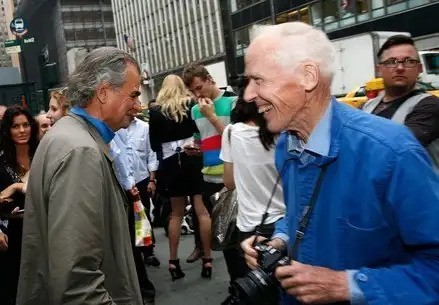
CUNNINGHAM AT WORK IN HIS FRENCH WORKMAN'S SMOCK
Last edited by Chris Knipp; 04-02-2024 at 10:39 AM.
-
Some snapshots from ND/NF
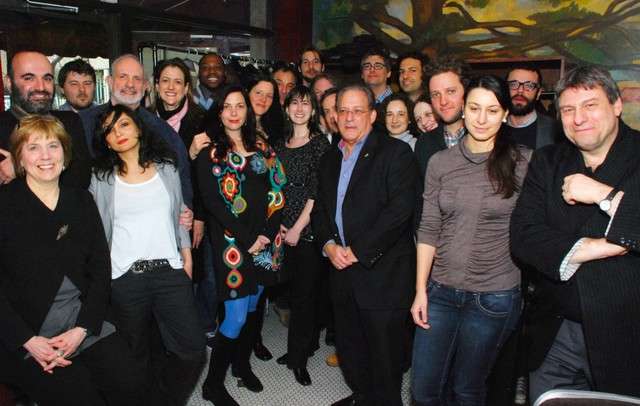
New Directors/New Films Class of 2010, at Josephina's, photo by Godlis
Far right: FSLC Director Richard Peña
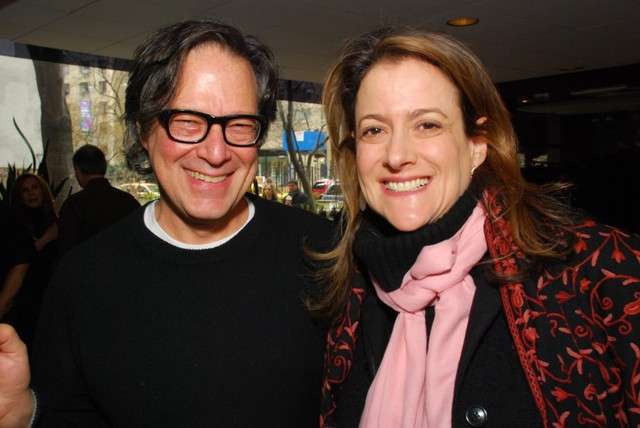
Phillip Gefter, producer of Bill Cunningham New York, and Mara Manus,
Executive Director of the Film Society, photo by Godlis
Last edited by Chris Knipp; 03-31-2010 at 04:08 PM.
 Posting Permissions
Posting Permissions
- You may not post new threads
- You may not post replies
- You may not post attachments
- You may not edit your posts
-
Forum Rules






 Reply With Quote
Reply With Quote






Bookmarks